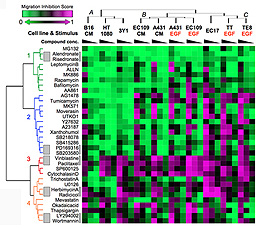Research Abstract
ケミカルゲノミクス研究が明らかにする、がん細胞における細胞遊走シグナルの多様性
A chemical genomic study identifying diversity in cell migration signaling in cancer cells
2012年11月8日 Scientific Reports 2 : 823 doi: 10.1038/srep00823

この研究の目的は、ケミカルゲノミクス的手法を用いて、がん細胞の遊走における制御シグナルの多様性と共通性を解析することである。創傷治癒アッセイにより、34種類の低分子化合物の影響を、10種類の遊走細胞において定量的に評価した。続いて、各細胞における化合物の遊走阻害プロファイルに対して階層的クラスタリングを行った。その結果、化合物は階層的クラスタリングによってそれらの標的分子に基づいて的確に分類された。さらに、本研究で用いたがん細胞は3つのクラスターに分類され、化合物は4つのクラスターにグループ分けされた。JNK阻害剤はすべてのタイプの細胞遊走を抑制したが、ROCK、GSK-3、p38MAPKの阻害剤は、一部の細胞株の遊走のみを抑制した。このように、我々の解析システムは、細胞遊走に対する共通なシグナル応答と細胞型特異的なシグナル応答を容易に区別することができた。
間木 重行1, 田代 悦1 & 井本 正哉1
- 慶應義塾大学理工学部 生命情報学科 ケミカルバイオロジー研究室
The aim of this study was to analyze the diversity and consistency of regulatory signaling in cancer cell migration, using a chemical genomic approach. The effects of 34 small molecular compounds were assessed quantitatively by wound healing assay in ten types of migrating cells. Hierarchical clustering was performed on the subsequent migration inhibition profile of the compounds and cancer cell types. The result was that hierarchical clustering accurately classified the compounds according to their targets. Furthermore, the cancer cells tested in this study were classified into three clusters, and the compounds were grouped into four clusters. An inhibitor of JNK suppressed all types of cell migration; however, inhibitors of ROCK, GSK-3 and p38MAPK only inhibited the migration of a subset of cell lines. Thus, our analytical system could easily distinguish between the common and cell type-specific signals responsible for cell migration.

